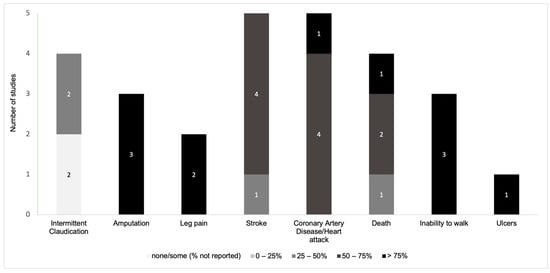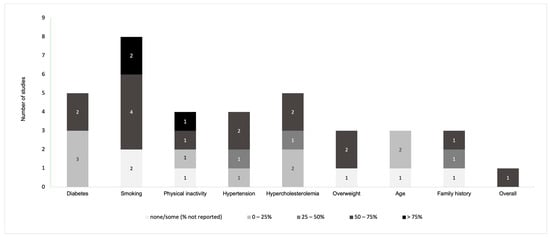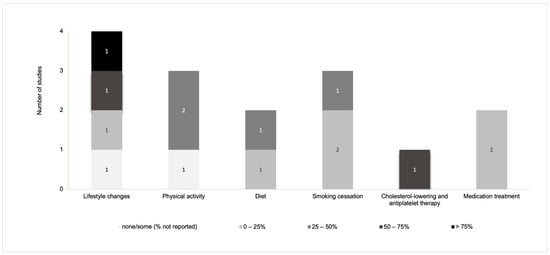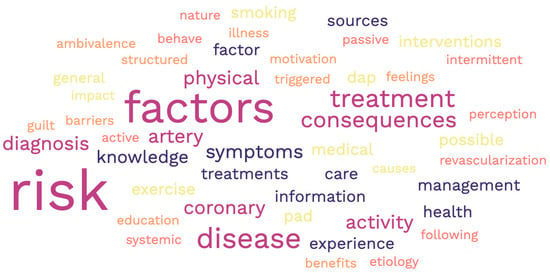Your browser does not fully support modern features. Please upgrade for a smoother experience.
Please note this is an old version of this entry, which may differ significantly from the current revision.
Subjects:
Cardiac & Cardiovascular Systems
Peripheral arterial disease (PAD) is the third leading cause of atherosclerotic cardiovascular morbidity worldwide, with high prevalence and associated complications, and is often overlooked and undertreated. Research has shown that there is a profound lack of PAD-related knowledge and awareness; additionally, information sources are not often reliable and accessible.
- awareness
- patient education as topic
- knowledge
- peripheral artery disease
1. Introduction
Peripheral arterial disease (PAD)—a chronic arterial occlusive disease of the lower extremities—is a powerful predictor for all-cause, cardiovascular, and cerebrovascular morbidity and mortality, especially in older adults [1,2,3]. It is the third leading cause of atherosclerotic cardiovascular morbidity worldwide, affecting approximately 202 million people [1]. Despite the high prevalence and associated complications, PAD is often overlooked and undertreated [4]. Research has shown there is a profound lack of PAD-related knowledge and awareness in the general population [5,6,7], as well as healthcare providers [8,9,10] and those diagnosed with this condition [11]. Additionally, information sources for PAD are often not reliable and accessible [12,13].
Patient education is essential in the care of those living with cardiovascular diseases (CVD) [14,15], including PAD [3,16]. Patients require information about responding to symptoms, risk factors, and how to self-manage their disease to reduce this excess risk [14]. Indeed, patient education leads to not only increased knowledge but increased physical activity, improved nutrition, tobacco cessation, and medication adherence, as well as reductions in anxiety and depressive symptoms [14,15]. Delays in the presentation and appropriate management of the condition may lead to complications such as ischaemia, amputation, and death [4]. Research shows that educating and supporting patients with CVD leads to a better understanding of their central role in disease management, making informed decisions about their care, and engaging in heart-healthy behaviours [17]. Many strategies are used by healthcare providers to educate their patients, from discharge education [18] to structured programs following an event [19]. However, improvements in patients’ disease-related knowledge and awareness following educational interventions are not always achieved, which can compromise patients’ outcomes and the progression of their disease [20,21,22]. In this context, identifying patients’ needs and knowledge gaps is important to guide healthcare providers in supporting their patients’ learning journey.
2. Measurement of Disease-Related Knowledge and Awareness in PAD Patients
Overall, disease-related knowledge and awareness in PAD patients were measured with regard to signs/symptoms and complications in twelve instruments (Figure 2) [11,21,22,29,31,32,33,36,37,38,39,40], risk factors in nine instruments (Figure 3) [11,21,22,29,30,31,36,38,40], pathophysiology in eight instruments (Figure 4) [11,29,31,32,36,37,38,40], and management and pharmacological therapy in six instruments (Figure 5) [31,35,36,38,39,40]. One of the studies presented general knowledge without describing specific areas [34]. None of the identified instruments included questions from all these knowledge areas.

Figure 2. Distribution of the knowledge and awareness about signs/symptoms of PAD evaluated in studies.

Figure 3. Distribution of the knowledge and awareness about risk factors of PAD evaluated in studies.

Figure 4. Distribution of the knowledge and awareness about the pathophysiology of PAD evaluated in studies.

Figure 5. Distribution of the knowledge of, and awareness about, management and pharmacological therapy of PAD evaluated in studies.
Among PAD signs/symptoms, four studies included knowledge questions about intermittent claudication. Of these, two studies reported the percentage of participants who identified intermittent claudication as a PAD sign or symptom (21.0% and 47.1%) [21,36] and two studies showed that patients did not effectively recognize intermittent claudication as a symptom of PAD [22,40]. Knowledge about other complications related to PAD was also included as the following: coronary artery disease/heart attack (n = 5 studies; median % of patients who identified this PAD complication = 65.7%; range = 58.8% to 77.0%) [11,29,31,33,38], stroke (n = 5; median % = 58.8%; range = 28.7% to 71.0%) [11,29,33,38,39], death (n = 4; median = 59.1%; range = 26.6% to 84.0%) [11,29,33,39], inability to walk (n = 3; median = 84.0%; range = 80.0% to 85.7%) [11,29,33], amputation (n = 3; median = 78.0%; range = 73.2% to 91.0%) [11,29,33], leg pain (n = 2; median = 86.4%; range = 85.7% to 87.0%) [11,33], and ulcers (n = 1; 76.0% participants identified this PAD complication) [33].
Among knowledge about risk factors, smoking was most commonly assessed (n = 6) with a median of 68.6% of participants identifying smoking as a PAD risk factor (range = 52.0% to 86.0%) [11,21,29,30,31,38]; two studies did not describe the percentage [22,40]. Knowledge about other PAD risk factors was also assessed as follows: diabetes (n = 5 studies; median % of participants who identified diabetes as a PAD risk factor = 21.6%; range = 8.0% to 63.2%) [11,29,30,31,38]; hypercholesterolemia (n = 5; median = 30.0%; range = 12.0% to 73.0%) [11,29,30,31]; physical inactivity (n = 3; median = 73.0%; range = 23.0% to 75.7%) [11,29,31] and one study did not describe the percentage [40]; hypertension (n = 4; median = 45.4%; range = 11.4% to 69.0%) [11,29,30,38]; being overweight (n = 2; median = 63.1%; range = 55.2% to 71.0%) [11,29], and one study did not describe the percentage [40]; age (n = 2; median = 12.9%; range = 4.0% to 21.7%) [31,38] and one without percentage [40]; and family history (n = 2; median = 50.9%; range = 36.8% to 65%) [11,29] and one without percentage [40].
Regarding the pathophysiology of PAD, two studies [29,40] investigated “what is PAD”, with 32.0% of participants knowing the response in one study [29]; the other study did not describe knowledge percentages [40]. Considering PAD diagnosis, 64.2% of respondents were aware of it in one study [11]. Two studies identified knowledge about dysfunctions in the circulatory system related to PAD, with knowledge percentages ranging from 21.0% to 26.0% [31,38].
Knowledge about PAD management varied across studies. Knowledge about “managing PAD for the rest of their lives/lifestyle” was evaluated in three studies, with a median of correct answers of 57.2% (range = 13.0% to 81.0%) [31,35,36]. In addition, one study reported that “most participants were aware that there were things they could do by themselves to manage their health condition” [40], but no extra information was reported. Knowledge about quitting smoking was also evaluated in three studies (median correct answers = 24.0%; range = 20.0% to 30%) [31,35,38]. Knowledge about self-management and adherence to health behaviours was assessed in terms of physical activity in two studies, with knowledge ranging from 35.0% to 48.0% [31,38]. Knowledge about following a healthy diet as an important tool in PAD management was reported in two studies, with a knowledge range of 10.0% to 32.0% [31,38].
Finally, four studies assessed knowledge about pharmacological therapy [31,36,38,39]. Of these, one study assessed overall knowledge about pharmacological therapy, with 65.0% of participants having knowledge about it [36]. In addition, two studies assessed knowledge about the importance of medication in the treatment of PAD (knowledge range = 4.0% to 12.0%) [31,38], and one study assessed knowledge about cholesterol-lowering therapy and antiplatelet therapy, with 75.8% of participants identifying knowledge about this [39].
The word cloud illustrates the most common terms in the questions and statements that are part of the included questionnaires. Risk factors, complications of PAD, and treatment were the terms found most frequently in these instruments (Figure 6).

Figure 6. Word cloud of most common terms included in the knowledge/awareness questions.
This entry is adapted from the peer-reviewed paper 10.3390/jcm13010107
This entry is offline, you can click here to edit this entry!
